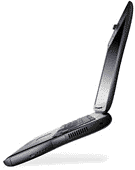The new PowerBook G4s are thin, lightweight, sleek, and fast.
They've got as many ports as a desktop computer and are not far behind
in terms of speed. Their RAM can be upgraded easily, they've got large,
bright screens, and they can connect to any wireless network
effortlessly.
But it sure isn't easy to repair them when things go wrong.
A friend of mine recently had the screen fail on her 15" aluminum PowerBook G4. I had a similar issue
with my 400 MHz titanium
PowerBook and decided that replacing the whole computer was cheaper
than having the old one repaired!
My friend was determined to repair hers, since it was so new. Apple
wanted over $1,000 for a new screen, but she was able to secure one via
eBay for under $700 - not exactly cheap.
I remember at the time mine was giving me problems, the local Apple
dealer told me that replacing something like a logic board or power
manager board in the G4 took several hours of unscrewing endless
half-centimeter screws just to gain access to the parts.
After having a replacement screen for my
1996 PowerBook 5300cs sitting
around for two years, I finally decided to attempt to install it while
I was back home for spring break. I figured that even if I did damage
something, at this point the computer was worth so little it didn't
matter.

Amazingly, it took me a total of about 30 minutes to get the new
screen installed. I couldn't believe how simple the process was, and I
didn't even need instructions! For those interested, it essentially
involved unscrewing three screws to release the keyboard, removing the
left-side screen hinge cover, unscrewing four screws in order to remove
the back of the lid, removing and installing the new screen (which
involved briefly disassembling the left screen hinge to get the screen
cable through), and then replacing the screws.
The new screen was a huge improvement.
Unfortunately, the computer's just as slow as it ever was, and it
really isn't too useful these days thanks to the ever-advancing
Internet and new software that's simply incompatible with older Mac OS
versions.
On top of that, something else seems to be on its way out. The
computer freezes up often, regardless of OS version.
Did older PowerBooks last longer than newer ones? Or were they just
more worthwhile to repair?

One thing's for sure . . . older PowerBooks put out a lot
less heat than today's machines. My 12" PowerBook gets
uncomfortably hot under the left wrist rest and above the keyboard. The
5300 gets slightly warm, but nothing beyond that. I remember my old
PowerBook 140 barely got warm at
all.
The 140 lasted a while, but the screen was what eventually developed
problems, caused by the wear on the screen cable from constantly
opening and closing the lid. However, the rest of it should still work
fine (but my AC adapter has disappeared).

I had good luck with my 333 MHz PowerBook G3. It was still
based on the "give the inner components enough space to let off heat"
principle, and the only issues I ever had with it was the fan shorting
out (just after the warranty was up, but at least it was an inexpensive
repair).
In terms of repairs, older PowerBooks like the 5300, 140, or G3 were
relatively simple to access compared to a modern PowerBook G4. Since it
took me such a short time to replace the screen on the 5300cs (and I'd
never done it before), someone who knew what they were doing should be
able to install it in a matter of a few minutes.
In 1998, a 10" screen probably would have set a user back a few
hundred dollars, and maybe another $50 for installation. So, they could
have their laptop (which at the time would have still been worth about
$1,000) repaired for under $500.
These days, it can cost users $1,000 to have their $1,200 laptop
repaired, and it's simply not worth bothering with it.
That said, Apple laptops aren't the only ones that suffer from these
problems. As users demand thinner and lighter notebook computers, one
of the sacrifices they have to make is the ability to have the machine
repaired if something goes wrong.
Older laptops - like the PowerBook G3 or my Dell Latitude CPx - had
more modular components. In fact, almost everything in the Dell could
be replaced modularly (CD, hard drive, logic board, audio system,
etc.), and the screws on the bottom are coded as to what they
unscrew.
Of course, the Dell has been a lot more unreliable than any other
notebook I've owned (and that leads me to wonder if they did this "easy
upgrade" thing for a reason!).
Modern laptops are convenient due to their size and weight
. . . but it's sadly impossible to expect them to have a life
span of more than a few years.





